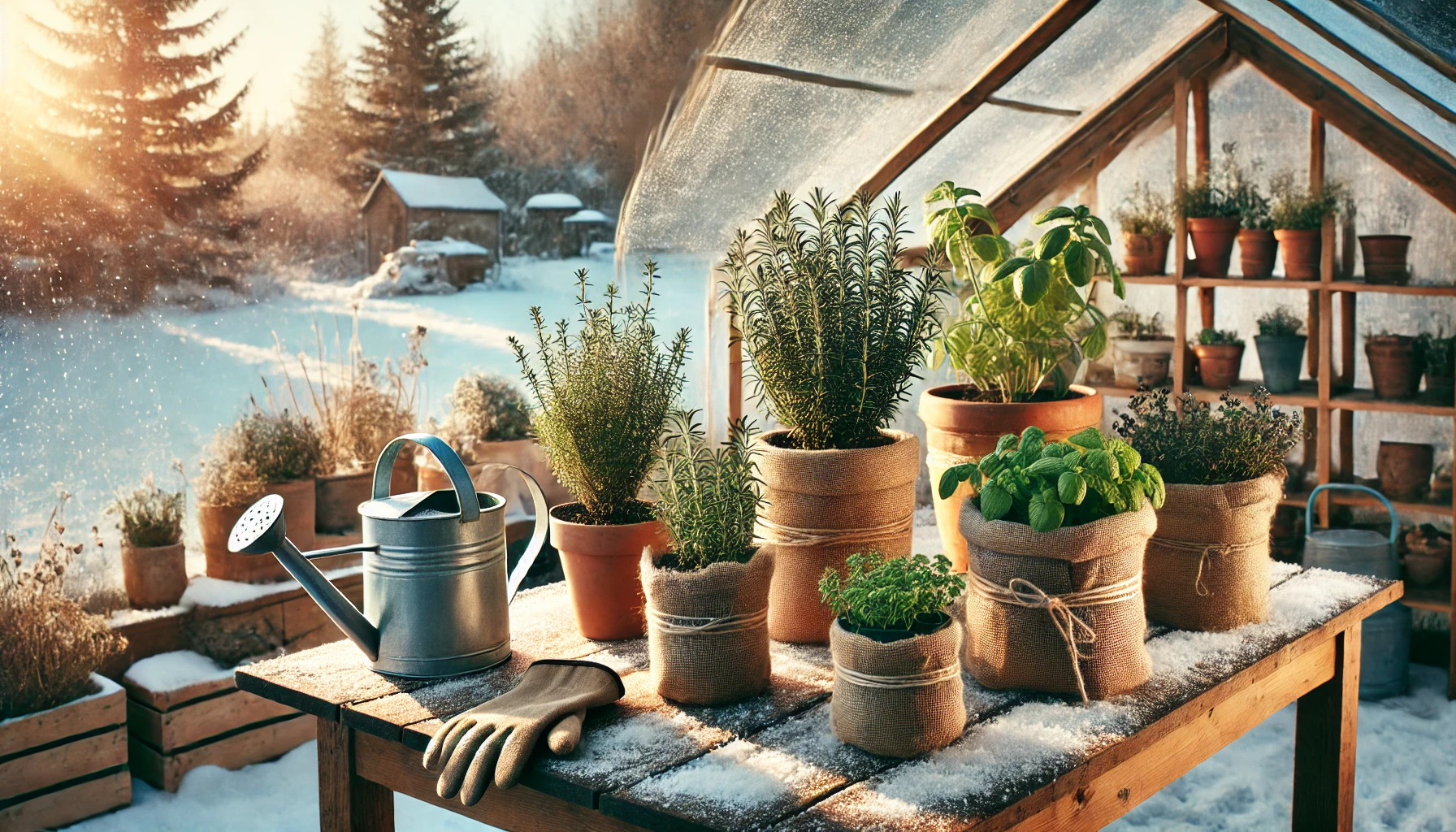Growing herbs in pots is a convenient way to have fresh flavors year-round, but winter presents unique challenges, especially for outdoor potted herbs. Cold temperatures, frost, and reduced sunlight can stress plants, causing them to wilt or die. With proper care, however, many herbs can survive and even thrive through the winter months. This guide will cover essential winter care tips to protect your outdoor potted herbs, ensuring they remain healthy and ready for use when spring arrives.
Understanding Herb Hardiness
Different herbs have varying levels of cold tolerance. Some are hardy and can withstand freezing temperatures, while others are tender and require extra protection.
Cold-Hardy Herbs (Can Survive Frost)
- Thyme – Hardy down to -20°F (-29°C)
- Rosemary (Arp or Hill Hardy varieties) – Survives mild winters
- Oregano – Can withstand frost with proper mulching
- Chives – Goes dormant but regrows in spring
- Sage – Hardy in most climates with some protection
- Mint – Dies back but returns in warmer seasons
Tender Herbs (Sensitive to Frost)
- Basil – Very sensitive to cold; should be brought indoors
- Cilantro – Can handle cool temperatures but not heavy frost
- Parsley – Can tolerate mild frost but needs covering
- Lemongrass – Requires indoor shelter in cold regions
- Stevia – Needs warmth and should be overwintered indoors
Identifying whether your herbs are hardy or tender will help determine the best winter care strategies.
Preparing Outdoor Potted Herbs for Winter
Step 1: Gradually Acclimate Herbs
Before the first frost, start acclimating potted herbs to cooler temperatures. Move them into a partially shaded, sheltered area for a few hours a day, gradually increasing their exposure to cold. This helps prevent shock when temperatures drop.
Step 2: Insulate the Pots
Potted plants are more vulnerable to freezing than in-ground plants since their roots are exposed to colder air. Protect them with these methods:
- Wrap pots in burlap or bubble wrap to insulate the roots.
- Place pots on wooden boards or bricks instead of direct ground contact to prevent heat loss.
- Group pots together to create a microclimate and reduce cold exposure.
Step 3: Use Mulch for Extra Protection
Applying mulch around the base of your herbs helps retain heat and moisture. Use materials like:
- Straw or hay – Provides excellent insulation
- Shredded leaves – A natural and cost-effective option
- Pine needles – Great for keeping moisture while allowing air circulation
Mulching 2-4 inches deep helps keep roots warm and protects against temperature fluctuations.
Step 4: Reduce Watering but Don’t Let Herbs Dry Out
During winter, plants grow slower and require less water. However, completely dry soil can lead to root damage. Follow these guidelines:
- Water when the top 1-2 inches of soil feel dry.
- Avoid watering late in the day to prevent overnight freezing.
- Use room-temperature water to avoid shocking the roots.
Overwatering can cause root rot, so it’s essential to find the right balance.
Step 5: Move Herbs to a Sheltered Location
For tender herbs, consider relocating them to a protected area, such as:
- Against a south-facing wall to absorb sunlight and radiate heat.
- Under a covered porch or patio to shield from wind and rain.
- Inside an unheated greenhouse for extra insulation.
If severe frost is expected, move pots into a garage or shed overnight and return them to daylight when temperatures rise.
Overwintering Herbs Indoors
If you live in an extremely cold climate, bringing potted herbs indoors may be the best option. Follow these steps for a smooth transition:
Step 1: Check for Pests Before Bringing Indoors
Inspect leaves and soil for aphids, spider mites, or whiteflies. If pests are present:
- Rinse leaves with water to remove insects.
- Use insecticidal soap for persistent infestations.
- Isolate plants for a few days before placing them near other indoor plants.
Step 2: Provide Enough Light
Indoor herbs need at least 6 hours of sunlight. If natural light is insufficient:
- Use LED grow lights positioned 6-12 inches above the plants.
- Rotate plants every few days to ensure even growth.
Step 3: Adjust Humidity Levels
Indoor air tends to be drier in winter. To maintain proper humidity:
- Place a tray of water with pebbles near the plants.
- Mist leaves occasionally (avoid overdoing it to prevent mold).
- Keep herbs away from heating vents or radiators that dry out the air.
Step 4: Maintain a Cool Indoor Temperature
Herbs prefer cooler temperatures (55-65°F / 13-18°C) at night to mimic outdoor conditions. Keep them in a room with good air circulation, but avoid direct drafts from windows or doors.
Protecting Herbs Left Outdoors in Winter
Some herbs can survive outdoors if given the right care. Here’s how to increase their chances of survival:
- Use Cloches or Row Covers – Small plastic or glass domes trap heat and protect herbs from frost.
- Build a Mini Greenhouse – Cover pots with clear plastic to create a warm, humid environment.
- Bury Pots in the Ground – This helps insulate the roots from extreme cold.
When to Start Preparing for Spring
By late winter, herbs will start showing signs of new growth. To prepare for spring:
- Gradually expose herbs to outdoor temperatures by placing them outside for a few hours each day.
- Remove excess mulch once the danger of frost has passed.
- Begin fertilizing lightly to support new growth.
Final Thoughts
Caring for outdoor potted herbs in winter requires extra attention, but with proper preparation, your plants can survive and thrive. Whether you choose to insulate pots, move herbs indoors, or use protective covers, these strategies will help keep your herbs healthy until warmer days return.

